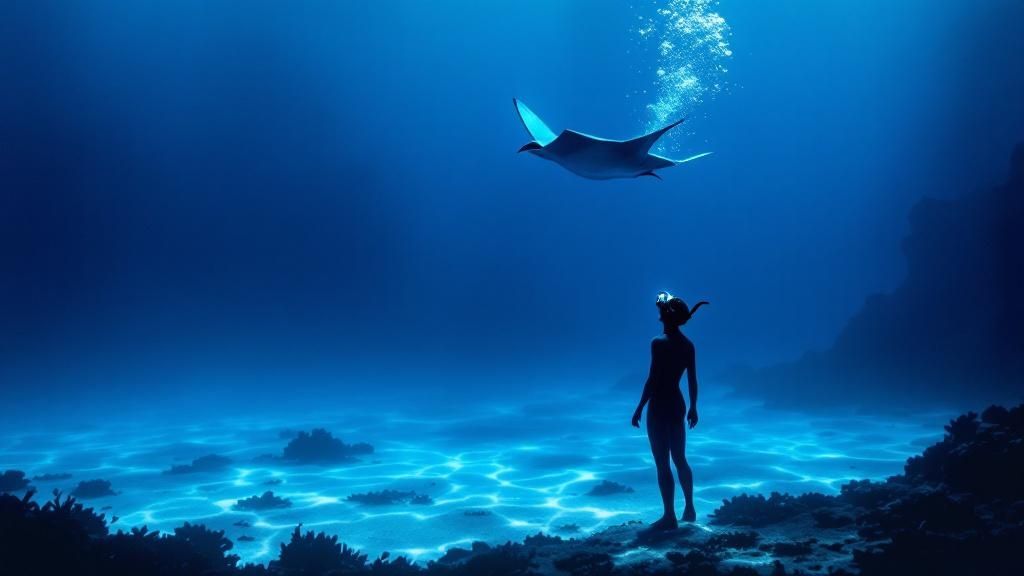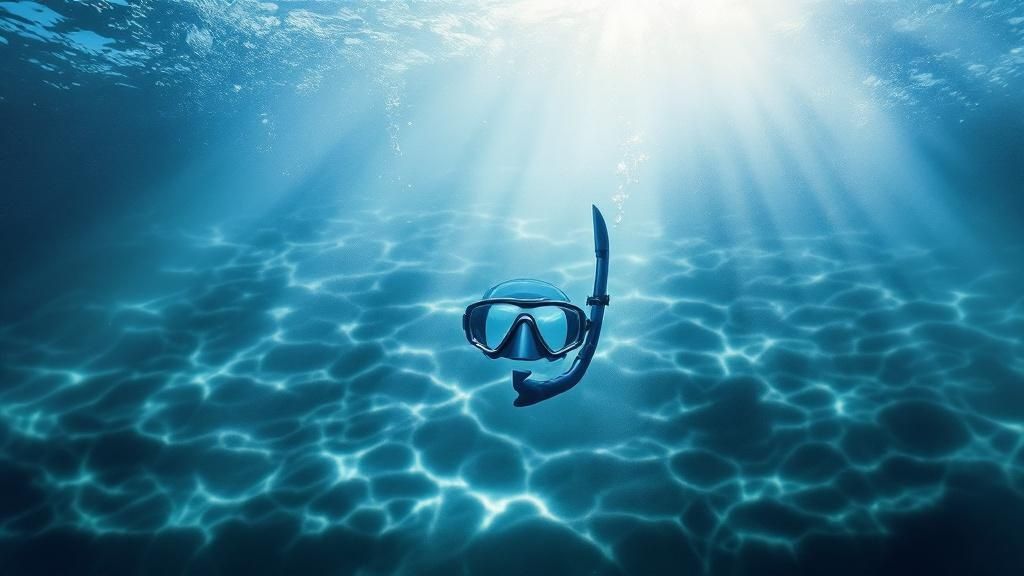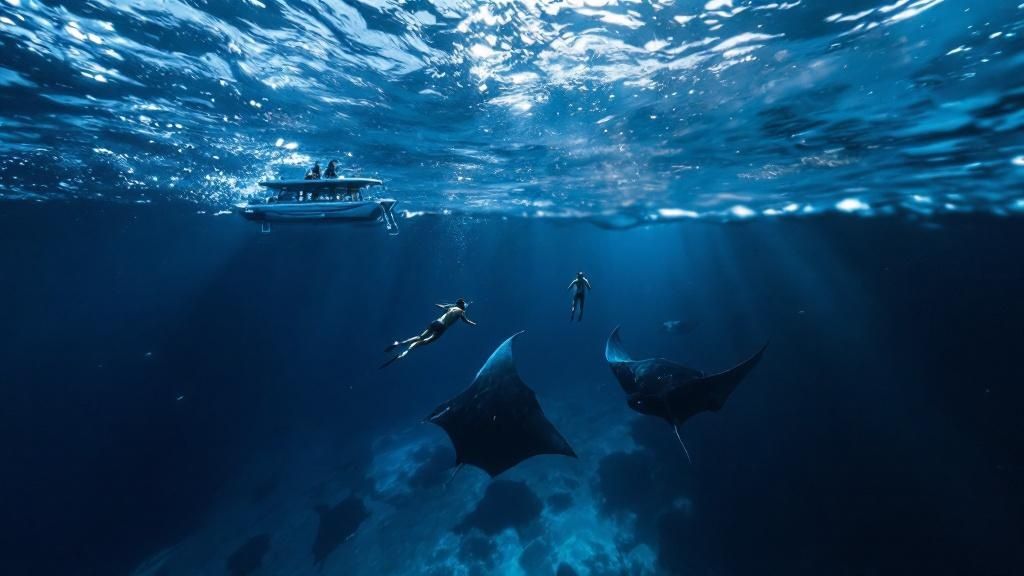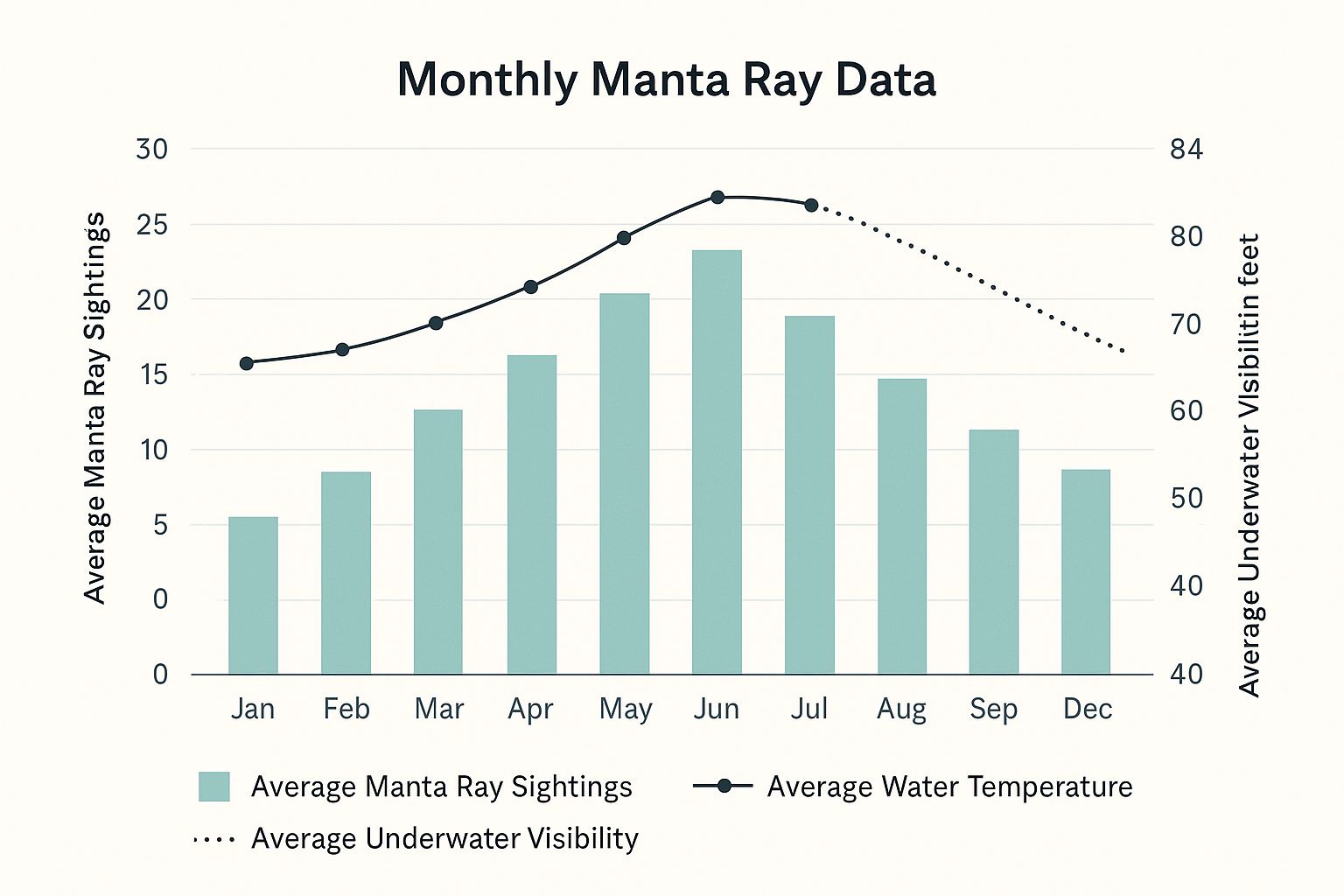Manta Ray Snorkel Kona: Best Tours & Tips in Hawaii
- Byron
- Jun 19
- 11 min read
Why Kona Creates The World's Most Magical Manta Ray Encounters

Imagine floating in the warm, clear Pacific as enormous, graceful creatures soar just inches below you. This isn't a rare stroke of luck; the manta ray snorkel kona experience is famous because of a unique blend of natural factors that make these waters a manta ray paradise. The secret lies in the Big Island’s volcanic history, which has created a special underwater landscape perfect for concentrating their favorite food.
Think of the sheltered bays along the Kona coast as a giant, natural funnel. Ocean currents, loaded with nutrients from the deep sea, push against the ancient underwater lava flows. This action causes massive blooms of microscopic plankton, the manta rays' primary food source. The bays then trap this plankton-rich water close to shore, creating a reliable, 24/7 buffet that draws mantas from all over to feed every single night.
A Recipe For Reliable Encounters
This special combination of geology and oceanography makes Kona the most consistent place on the planet to see manta rays. With a permanent food supply right at their doorstep, the mantas have no reason to leave. This amazing reliability is why local tour operators can confidently promise an unforgettable adventure.
This geological gift translates into an exceptionally high chance of a breathtaking encounter for visitors. Kona’s global reputation is built on this very consistency.
The manta ray snorkel kona adventure has an impressive 80-90% success rate for sightings throughout the entire year.
This predictable gathering makes the Kona coast a top destination worldwide for seeing these animals in their natural element. You can discover more insights about Kona's manta sightings to see just how remarkable this location is.
Knowing these natural secrets helps to show why your odds of an incredible experience are so high. To learn how you can be a part of this amazing natural event, check out our complete adventure guide.
Stepping Into The Night: What Really Happens on a Manta Tour
Forget your typical daytime snorkeling trip. The Kona manta ray night snorkel is an adventure that feels less like a simple swim and more like being part of a live nature documentary. Your journey starts as the sun sets over the Pacific, painting the sky with brilliant colors. You'll board a boat with a small group of fellow explorers and head out into the ocean as twilight takes over.
The real show begins when your boat arrives at a special spot, either Manta Village or Manta Heaven. This is where your tour guides turn into underwater stage directors. They set up powerful, submerged lights that transform the dark water into a glowing amphitheater. This isn't just to help you see; it's a clever tactic rooted in simple biology.
The Science Behind the Spectacle
The entire experience hinges on creating a concentrated, irresistible meal for the mantas. Plankton, the microscopic creatures that manta rays love to eat, are naturally drawn to light.
The tour boats' bright lights act like a giant beacon, pulling in massive clouds of plankton from the dark waters.
This creates a glowing, all-you-can-eat buffet that reliably attracts Kona's local manta ray population.
The rays glide gracefully into the light, performing an underwater ballet of barrel-rolls and loops to filter-feed on the dense plankton. You can learn more about this unforgettable night adventure in our dedicated article.
This smart use of light and nature is the secret to such consistent and breathtakingly close encounters. You'll float comfortably on the surface, holding onto a specially designed light board, watching these gentle giants feed just inches beneath you.
To understand the difference between day and night encounters, it helps to see a direct comparison. This table breaks down what you can expect from each experience.
Night vs Day Manta Ray Encounters Comparison
Comparing the differences between night and day manta ray snorkeling experiences, including visibility, manta behavior, and success rates.
Aspect | Night Snorkeling | Day Snorkeling | Success Rate |
|---|---|---|---|
Manta Behavior | Actively feeding in concentrated areas, performing barrel rolls and gliding close to the surface. | Typically traveling, cleaning, or passively swimming. Less predictable behavior. | High at night. |
Attraction Method | Powerful lights attract plankton, creating a reliable "buffet" for the mantas. | No specific attractant; encounters are based on chance and location. | High at night. |
Visibility | Focused on a brightly lit "stage" created by boat lights. Dark outside the light. | Dependent on general water clarity and time of day. Can be excellent or poor. | Variable during the day. |
Overall Experience | Immersive, predictable, and focused on up-close feeding displays in one spot. | More of a "safari" style search, with a lower chance of seeing mantas up close. | High at night. |
The takeaway is clear: while a daytime encounter is possible, the night snorkel is specifically designed to maximize your chances of a close and personal interaction with these amazing animals.
The infographic below illustrates how different factors throughout the year, like water temperature and visibility, contribute to the prime viewing season.
As the data shows, the summer months consistently provide the best mix of high sighting numbers and fantastic underwater conditions for an unforgettable experience.
Manta Village vs Manta Heaven: Choosing Your Perfect Spot

Picking the right spot for your manta ray snorkel kona adventure is a key decision that will define your evening. While both main sites offer fantastic viewing opportunities, they cater to different comfort levels and preferences. Think of it like choosing between two incredible concert venues—both have amazing music, but the seating and atmosphere are completely different.
Your tour operator will usually make the final decision based on the day's conditions, such as weather, ocean currents, and where the mantas have been most active. Still, understanding what makes each site unique will help you know what to expect.
Manta Village (Keauhou Bay)
Often seen as the most dependable and classic location, Manta Village is situated near the Sheraton Kona Resort. It is the more sheltered of the two sites, making it a great option for anyone who might be worried about getting seasick. The bay's calm waters and consistent manta sightings have made it a go-to for many tour companies.
Because it's protected from the open ocean swells, tours here are less likely to be canceled due to rough water. This makes it a reliable choice for a great experience any time of year.
Manta Heaven (Garden Eel Cove)
Just north of the Kona airport, you'll find Manta Heaven, a location known for its remarkable underwater scenery. The sandy ocean floor is home to thousands of garden eels that pop their heads out of the sand, creating a surreal scene before the mantas even show up. This site is a bit deeper than Manta Village, with depths ranging from 20 to 50 feet, which provides a stunning, dramatic backdrop for the manta ballet.
As you seek out the best night experience available, you'll learn that conditions at Manta Heaven are a big part of the tour plan. Both sites are prime locations for these encounters thanks to their unique underwater features, which you can read more about on KonaSnorkelTrips.com.
Meeting The Stars: Kona's Incredible Manta Ray Community
When you join a manta ray snorkel kona tour, you aren't just observing random wildlife; you're actually meeting local celebrities. The waters off the Kona coast host one of the most well-documented and thriving manta ray populations on the entire planet. For these gentle giants, this isn't a temporary stop—it’s their home, a permanent community with names, personalities, and life stories that have been tracked by researchers for decades.
Think of it like recognizing the cast of a long-running show. You might meet “Lefty,” who is easily identified by a unique marking on her left wing, or “Big Bertha,” a huge and gentle female who has been a crowd favorite for years. How is this possible? Each manta ray has a unique pattern of spots on its belly, which acts like an underwater fingerprint. This natural marker lets scientists and guides identify and follow individual rays, building a rich history for each animal.
A Thriving Underwater Society
Knowing that you’re visiting a real community adds a profound layer to the experience. It changes a simple tourist activity into a meaningful connection with a specific group of animals. These perfect conditions—sheltered bays, an abundance of plankton, and dedicated conservation efforts—are what support this incredible population. Current estimates suggest that over 450 individual manta rays call these feeding grounds home, which is why sightings are so reliable.
The unique underwater landscape, with its clear water and sandy bottom, allows the tour lights to shine deep into the ocean. This illuminates the plankton and creates a brilliant stage for the mantas' nightly feast. You can discover more about Kona’s manta ray population and the science that makes it all possible. This strong community dynamic is what makes the encounter so special—you're not just a spectator, but an invited guest to a spectacular, long-running dinner party, getting to know the individual "stars" of the show.
Getting Ready for Your Underwater Adventure

What to Bring and Wear
Even in tropical Hawaii, the combination of night ocean temperatures and a breezy boat ride can feel chilly. Most tour operators provide wetsuits, which are a must for staying warm in the water while you watch the mantas. For the boat ride, layering is your best strategy.
Here's a quick look at what we recommend to ensure you're comfortable from start to finish.
| Essential Gear Checklist for Manta Ray Snorkeling | | :--- | :--- | :--- | :--- | | Item Category | Essential Items | Optional Items | Notes | | Clothing | Swimsuit, Towel, Dry change of clothes, Sweatshirt or jacket | Hat, Flip-flops or water shoes | Wear your swimsuit under your clothes to make changing easier. | | Health & Safety | Reef-safe sunscreen (for sunset tours), Seasickness medication | Reusable water bottle, Small first-aid kit | Take any motion sickness medicine before boarding the boat for it to be effective. | | Gear | Provided wetsuit, snorkel, and mask | Personal prescription mask, GoPro or waterproof camera | Most tours provide all necessary gear, so you only need personal items. | | Personal Items | Photo ID, Credit card/cash for gratuities | Dry bag for electronics | Check with your tour operator about their payment options and policies. |
This simple packing list covers the essentials. By bringing layers and a dry set of clothes, you'll be much more comfortable on the boat ride back to shore.
Preparing for the In-Water Experience
Getting mentally and physically ready for the water is just as important as packing the right gear. It's common for people to have questions about swimming in the dark or their swimming ability. The great news is that these tours are designed to be accessible for almost everyone.
You'll typically hold onto a large, sturdy floatation board that has powerful lights shining down into the water. You are not required to swim around freely. This setup allows you to relax and just float, watching the amazing ballet below.
If you start to feel anxious, focus on taking slow, deep breaths—it’s a simple trick that really works. Be sure to share any concerns with your guides. They are trained professionals whose main job is to ensure you are safe and comfortable. With the right gear and a calm mindset, you’re all set to witness one of nature's most incredible performances.
Choosing Your Tour: What Separates Great From Unforgettable
With a sea of companies offering a manta ray snorkel kona experience, picking the right one can feel a bit daunting. Think of it like choosing a guide for a once-in-a-lifetime journey; the right person can turn a simple trip into a legendary adventure. The best operators don’t just show you the manta rays—they create an entire experience around safety, respect for the animals, and a genuine love for the ocean. Understanding what sets these tours apart is key to making your night on the water truly special.
Boat Size and Group Intimacy
A major difference between tours comes down to the size of the boat and the group. It's like the difference between seeing your favorite band in a massive stadium versus an intimate, acoustic show. The big "cattlemarans" can fit more people, which often translates to a lower price per person. However, smaller tour groups offer a far more personal and relaxed experience.
Smaller boats almost always mean more personal attention from the guides.
You'll have more room at the flotation board, ensuring you get a front-row, unobstructed view.
The atmosphere is typically calmer, letting you soak in the magic of the moment without feeling crowded.
While larger boats are very stable, a smaller, more focused group can be the difference between just seeing the mantas and truly connecting with the wonder of the experience.
Vetting Operators for Safety and Sustainability
Beyond the size of your group, a company’s dedication to safety and environmental ethics is critical. Never hesitate to ask about a tour's safety record, the certifications their guides hold (lifeguard training is a huge plus), and their specific rules for conduct in the water. Responsible operators are always proud to share this information. They are the ones who actively participate in conservation and enforce a strict no-touching policy to protect the mantas' delicate mucous coating.
Choosing a tour is an investment in a lifelong memory. With around 80,000 visitors enjoying this activity each year, your choice directly supports the local economy and helps maintain a high standard for responsible tourism. The sighting success rate of 80-90% means you're almost guaranteed to see these gentle giants, so make sure you pick a company that also guarantees a safe and ethical encounter. You can discover more about the unforgettable Hawaii marine tours and what makes an operator stand out. By asking the right questions, you're not just booking a tour; you're helping protect these magnificent creatures for years to come.
Making Magic: How To Turn Good Into Unforgettable
A good manta ray snorkel kona tour gets you into the water with these gentle giants. An unforgettable one, however, is created by understanding how to behave during those precious moments. Picture yourself as an invited guest to a grand, underwater ballroom; knowing the proper etiquette not only shows respect but also guarantees you the best seat in the house.
The most crucial rule is to remain passive. You'll be holding onto a flotation board, so your main job is to simply relax and be an observer. Avoid kicking your fins or making big splashes. This can disrupt the mantas' feeding patterns and stir up sediment from the seafloor, which clouds the water and spoils the view for everyone. Try to be like a floating log—the less you move, the more comfortable the mantas will feel, often gliding right beneath you.
Reading the Underwater Room
Learning to observe manta behavior can completely change your experience. When you see mantas doing graceful barrel rolls, it means they are in full feeding mode, swooping through the clouds of plankton drawn to the lights. This is the main event! If you see them just cruising by without feeding, they might just be passing through the area.
Recognizing these behaviors helps you anticipate their movements and truly appreciate the spectacle unfolding below. A key part of this is practicing good underwater etiquette, which helps you become a more responsible marine life enthusiast. To learn more, you might be interested in our guide covering top tours and experience tips.
Beyond the Manta Encounter
Your connection to Hawaii’s amazing marine world doesn't have to end when you climb back on the boat. Let the inspiration from your tour encourage you to explore other fantastic snorkeling spots around Kona, like Kealakekua Bay or Two Step. Each location offers a different slice of Hawaii's vibrant reef life, from schools of colorful fish to resting green sea turtles. By extending your adventure, you turn a single tour into a much deeper appreciation for the entire underwater ecosystem.
Ready to book an experience that respects both you and these magnificent creatures? [Book your Manta Ray Night Snorkel Kona Hawaii Tour today!](https://www.mantaraynightsnorkelhawaii.com)

Comments